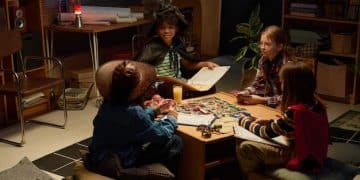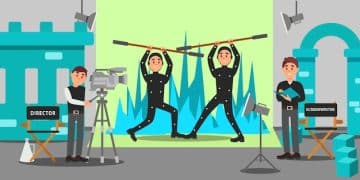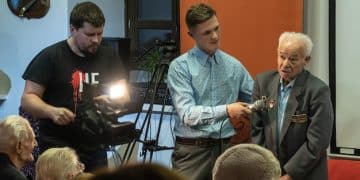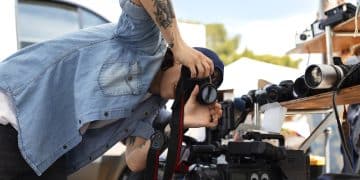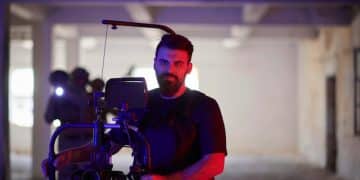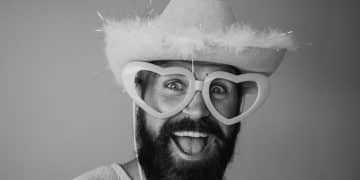Special Effects Secrets: Finale Moments Revealed by VFX Teams
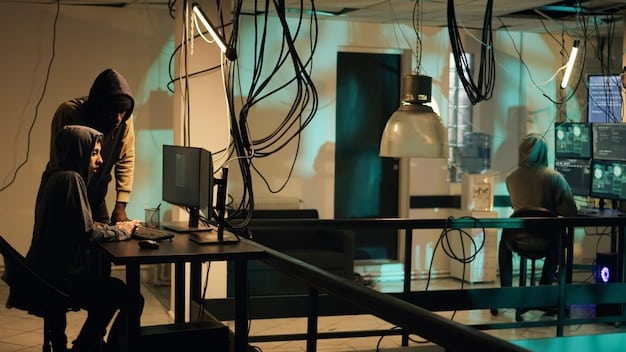
Visual effects (VFX) teams employ a vast array of techniques, from CGI and compositing to matte painting and motion capture, to create the spectacular and memorable series finale moments that leave audiences in awe.
Ever wondered how those mind-blowing series finale moments are brought to life? The secrets lie within the skillful hands of special effects secrets: how visual effects teams create mind-blowing series finale moments. Beyond just CGI, it’s a blend of artistry, technology, and sheer creative genius.
The Art and Science of Visual Effects in Series Finales
Series finales are meant to be memorable, leaving a lasting impact on viewers. Visual effects play a crucial role in achieving this, often pushing the boundaries of what’s possible on screen. It’s where storytelling meets technological innovation.
But what exactly goes into creating these stunning visuals? It’s more than just adding explosions and spaceships. It’s a carefully orchestrated process that involves a team of talented artists and technicians.
Key VFX Techniques Used in Finales
From subtle enhancements to breathtaking spectacles, visual effects teams employ a variety of techniques to create unforgettable moments. Understanding these techniques provides insight into the complexities of the production process.
- CGI (Computer-Generated Imagery): Creating characters, objects, and environments from scratch using computer software.
- Compositing: Combining multiple visual elements into a single, seamless image.
- Matte Painting: Creating realistic backgrounds and environments using digital or traditional painting techniques.
- Motion Capture: Recording the movements of actors to create realistic animations for digital characters.
These techniques, when used effectively, can elevate a series finale from good to extraordinary, leaving a lasting impression on viewers.
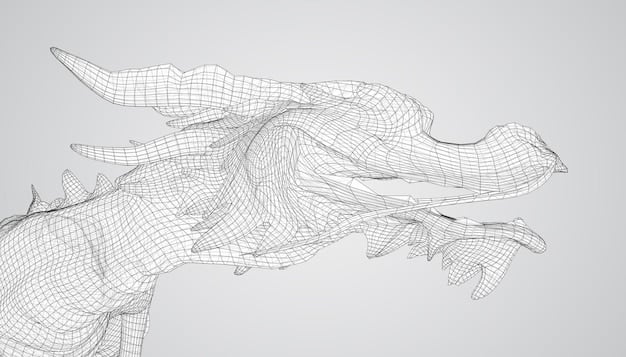
Ultimately, the goal of VFX in a series finale is to enhance the narrative and create a visual experience that resonates with the audience, making the ending truly unforgettable.
Planning and Pre-Visualization: The Foundation of Great VFX
Before any digital brushstrokes are applied, extensive planning and pre-visualization are crucial. This stage lays the groundwork for the visual effects and ensures that the final product aligns with the director’s vision.
Pre-visualization, or “previs,” involves creating simplified versions of complex scenes using 3D animation. This allows the director, VFX supervisor, and other key personnel to experiment with camera angles, lighting, and overall composition before filming begins.
The Role of the VFX Supervisor
The VFX supervisor is the linchpin of the visual effects process, bridging the gap between the director’s creative vision and the technical execution of the effects. They are involved from the earliest stages of pre-production and stay on through post-production.
Their responsibilities include:
- Overseeing the entire VFX process from start to finish.
- Collaborating with the director to establish the desired look and feel of the effects.
- Managing the VFX budget and ensuring that the effects are delivered on time and within budget.
- Supervising the work of the VFX artists and technicians.
Effective planning and pre-visualization, guided by a skilled VFX supervisor, are essential to creating seamless and impactful visual effects for a series finale.
Without meticulous planning, even the most talented artists can struggle to deliver the desired results, potentially leading to budget overruns and missed deadlines.
The Evolution of VFX Technology: Past, Present, and Future
Visual effects technology has come a long way since the early days of filmmaking. From practical effects and stop-motion animation to photorealistic CGI, the evolution of VFX has transformed the way stories are told on screen.
The shift from practical effects to CGI has been gradual, with each approach offering its own unique advantages and challenges. While practical effects can offer a tangible sense of realism, CGI allows for greater flexibility and control over the final result.
Key Milestones in VFX History
Several groundbreaking films and television series have pushed the boundaries of visual effects technology, paving the way for the innovations we see today.
- “2001: A Space Odyssey” (1968): Pioneered the use of practical effects to create realistic space environments.
- “Star Wars” (1977): Revolutionized visual effects with its innovative use of motion control photography and miniature models.
- “Jurassic Park” (1993): Introduced photorealistic CGI dinosaurs to the world, blurring the line between reality and fantasy.
- “The Lord of the Rings” trilogy (2001-2003): Showcased the power of motion capture technology to create believable digital characters.
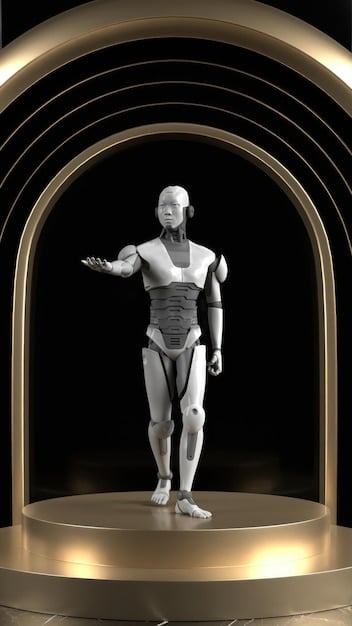
As technology continues to evolve, the possibilities for visual effects are virtually limitless, promising even more spectacular and immersive experiences for audiences in the years to come.
Blending Practical and Digital Effects: Achieving Seamless Realism
While CGI has become increasingly prevalent in modern filmmaking, practical effects still play a vital role in creating believable and immersive visuals. In many cases, the most effective approach involves blending practical and digital effects.
Practical effects offer a tangible sense of realism that can be difficult to replicate with CGI alone. They can also provide valuable reference points for VFX artists, helping them to create more realistic digital enhancements.
The Benefits of Combining Approaches
Combining practical and digital effects can offer several advantages:
- Enhanced Realism: Practical effects can provide a foundation of realism that is then enhanced with digital elements.
- Cost-Effectiveness: In some cases, practical effects can be more cost-effective than creating everything digitally.
- Improved Performance: Actors can interact with practical elements on set, leading to more natural and believable performances.
By carefully blending practical and digital effects, filmmakers can create visuals that are both spectacular and believable, immersing audiences in the story like never before.
Achieving this seamless integration requires close collaboration between the practical effects team and the VFX team, ensuring that both approaches complement each other.
Case Studies: Iconic Series Finale VFX Moments
Examining specific examples of series finale VFX successes can provide insights into the planning, execution, and impact of effective visual effects.
These case studies illustrate the diverse ways in which visual effects can be used to enhance storytelling and create memorable moments for audiences.
Examples of Outstanding VFX in Series Finales
Here are some notable examples of series finales that featured exceptional visual effects:
- “Breaking Bad”: The subtle but effective use of visual effects to enhance the tension and drama of the final episode.
- “Game of Thrones”: The epic battle sequences and dragon flights that showcased the power of large-scale CGI.
- “Six Feet Under”: The emotional and visually stunning montage of future deaths that provided closure for the characters and the audience.
These examples demonstrate that visual effects are not just about spectacle; they can also be used to enhance character development, create emotional resonance, and provide a satisfying conclusion to a beloved series.
Ultimately, the most successful VFX moments are those that serve the story and enhance the overall viewing experience.
The Future of VFX: What’s Next for Series Finales?
As technology continues to advance, the future of visual effects in series finales looks brighter than ever. New tools and techniques are constantly being developed, pushing the boundaries of what’s possible on screen.
One of the most promising developments is the increasing use of artificial intelligence (AI) in VFX. AI can automate many of the tedious and time-consuming tasks involved in visual effects production, allowing artists to focus on the more creative aspects of their work.
Emerging Trends in VFX Technology
Several emerging trends are poised to shape the future of visual effects:
- AI-powered VFX tools: Automating tasks such as rotoscoping, compositing, and animation.
- Real-time rendering: Allowing artists to see the final result of their work in real-time, speeding up the production process.
- Virtual production: Using virtual environments and real-time compositing to create more immersive and cost-effective productions.
These advancements promise to make visual effects more accessible, efficient, and impactful, allowing filmmakers to create even more spectacular and immersive series finales in the years to come.
In the future, we can expect to see even more seamless integration of visual effects and storytelling, blurring the line between reality and fantasy even further.
| Key Point | Brief Description |
|---|---|
| 🎬 VFX Techniques | CGI, compositing, matte painting, and motion capture enhance finales. |
| 👨💼 VFX Supervisor | Oversees VFX, bridging the director’s vision with technical execution. |
| 🚀 VFX Evolution | From practical effects to CGI, technology transforms storytelling. |
| 🤖 AI in VFX | AI automates tasks, allowing artists to focus on creativity. |
Frequently Asked Questions
▼
The VFX Supervisor oversees all visual effects, ensuring they align with the director’s vision, are on budget, and completed on time, managing artists and technicians.
▼
Common techniques include CGI (Computer-Generated Imagery), compositing, matte painting for backgrounds, and motion capture to animate digital characters realistically.
▼
VFX has evolved from practical methods and stop-motion to sophisticated CGI, significantly altering how stories are narrated on screen. Technology has evolved incredibly.
▼
Combining offers realism, cost-effectiveness, and better actor performance, merging tangible and digital to create spectacular, believable on-screen visuals seamlessly.
▼
Using AI, real-time rendering, and virtual production is evolving final episodes. As technology advances, final episodes should become more spectacular.
Conclusion
From the early days of practical effects to the cutting-edge technology of today, visual effects have played a pivotal role in creating memorable series finale moments. As technology continues to evolve, the possibilities for VFX are virtually limitless, promising even more spectacular and immersive experiences for audiences in the years to come. The integration of AI and real-time rendering will undoubtedly shape the future of visual storytelling, ensuring that series finales continue to push the boundaries of what’s possible on screen.
